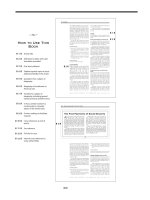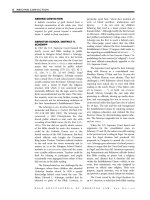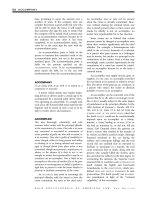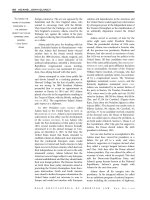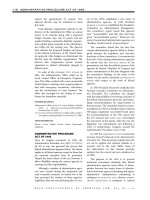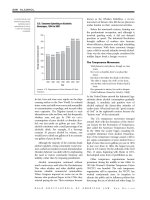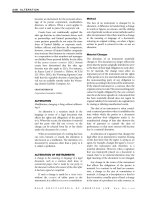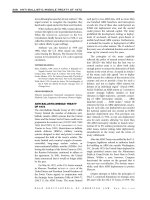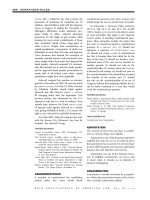Gale Encyclopedia Of American Law 3Rd Edition Volume 4 P2 ppsx
Bạn đang xem bản rút gọn của tài liệu. Xem và tải ngay bản đầy đủ của tài liệu tại đây (803.77 KB, 10 trang )
k
How to Use This
Book
1
1
2
4
3
2
3
4
5
6
7
8
9
10
11
12
13
XIII
5
6
7
9
10
13
12
11
8
GALE ENCYCLOPEDIA OF AMERICAN LAW, 3RD E DITION
XIV HOW TO USE THIS BOOK
Contributors
Editorial Reviewers
Patricia B. Brecht
Matthew C. Cordon
Frederick K. Grittner
Halle Butler Hara
Scott D. Slick
Contributing Authors
Richard Abowitz
Paul Bard
Joanne Bergum
Michael Bernard
Gregory A. Borchard
Susan Buie
James Cahoy
Terry Carter
Stacey Chamberlin
Sally Chatelaine
Joanne Smestad Claussen
Matthew C. Cordon
Richard J. Cretan
Lynne Crist
Paul D. Daggett
Susan L. Dalhed
Lisa M. DelFiacco
Suzanne Paul Dell’Oro
Heidi Denler
Dan DeVoe
Joanne Engelking
Mark D. Engsberg
Karl Finley
Sharon Fischlowitz
Jonathan Flanders
Lisa Florey
Robert A. Frame
John E. Gisselquist
Russell L. Gray III
Frederick K. Grittner
Victoria L. Handler
Halle Butler Hara
Lauri R. Harding
Heidi L. Headlee
James Heidberg
Clifford P. Hooker
Marianne Ashley Jerpbak
David R. Johnstone
Andrew Kass
Margaret Anderson Kelliher
Christopher J. Kennedy
Anne E. Kevlin
John K. Krol
Lauren Kushkin
Ann T. Laughlin
Laura Ledsworth-Wang
Linda Lincoln
Theresa J. Lippert
Gregory Luce
David Luiken
Frances T. Lynch
Jennifer Marsh
George A. Milite
Melodie Monahan
Sandra M. Olson
Anne Larsen Olstad
William Ostrem
Lauren Pacelli
Randolph C. Park
Gary Peter
Michele A. Potts
Reinhard Priester
Christy Rain
Brian Roberts
Debra J. Rosenthal
Mary Lahr Schier
Mary Scarbrough
Stephanie Schmitt
Theresa L. Schulz
John Scobey
Kelle Sisung
James Slavicek
Scott D. Slick
David Strom
Linda Tashbook
Wendy Tien
M. Uri Toch
Douglas Tueting
Richard F. Tyson
Christine Ver Ploeg
George E. Warner
Anne Welsbacher
Eric P. Wind
Lindy T. Yokanovich
XV
DOT
See TRANSPORTATION, DEPARTMENT OF.
DOUBLE ENTRY
A bookkeeping system that lists each transaction
twice in the ledger.
Double-entry bookkeeping is a method
whereby every transaction is shown as both a
debit and a credit. This is done through the use of
horizontal rows and vertical columns of num-
bers. The reason for the use of this bookkeeping
method is that if the total of horizontal rows and
vertical columns is not the same, it is easier to
find mistakes than when the records are kept
with only a single entry for each item.
DOUBLE INDEMNITY
A term of an insurance policy by which the
insurance company promises to pay the insured
or the beneficiary twice the amount of coverage
if loss occurs due to a particul ar cause or set of
circumstances.
DOUBLE INDEMNITY clauses are found most
often in life insurance policies. In the case of the
accidental death of the insured, the insurance
company will pay the beneficiary of the policy
twice its
FACE VALUE. Such a provision is usually
financed through the payment of higher pre-
miums than those paid for a policy that entitles
a beneficiary to recover only the face amount of
the policy, regardless of how the insured died.
In cases where the cause of death is unclear,
the insurance company need not pay the
proceeds until the accidental nature of death is
sufficiently established by a
PREPONDERANCE OF
EVIDENCE
. A beneficiary of such a policy may
sue an insurance company for breach of con-
tract to enforce his or her right to the proceeds,
whenever necessary.
DOUBLE INSURANCE
Duplicate protection provided when two compa-
nies deal with the same individual and undertake
to indemnify that person against the same losses.
When an individual has
DOUBLE INSURANCE,
he or she has coverage by two different insu-
rance companies upon the identical interest in
the identical subject matter. If a husband and
wife have duplicate me dical insurance coverage
protecting one another, they would thereby
have double insurance. An individual can rarely
collect on double insurance, however, because
this would ordinarily constitute a form of
UNJUST
ENRICHMENT
, and a majority of insurance con-
tracts contain provisions that prohibit this.
DOUBLE JEOPARDY
A second prosecution for the same offense after
acquittal or conviction or multiple punishments
for same offense. The evil sought to be avoided
by prohibiting double jeopardy is double trial
and double conviction, not necessarily double
punishment.
D
(cont.)
1
The FIFTH AMENDMENT to the U.S. Constitu-
tion provides, “No person shall … be subject
for the same offence [sic] to be twice put in
JEOPARDY of life or li mb. ” This provision,
known as the
DOUBLE JEOPARDY Clause, prohibits
state an d federal governments from prosecut-
ing individuals for the sam e crime on
more than one occasion, or imposing more
than one punishment for a single offense. Each
of the 50 states offers similar protection
through its own c onstitution, statutes, and
COMMON LAW.
Five policy considerations underpin the
double jeopardy doctrine: (1) preventing the
government from employing its superior
resources to wear down and erroneously convict
innocent persons; (2) protecting individuals
from the financial, emotional, and social con-
sequences of successive prosecutions; (3) pre-
serving the finality and integrity of criminal
proceedings, which would be compromised
were the state allowed to arbitrarily ignore
unsatisfactory outcomes; (4) restricting prose-
cutorial discretion over the charging process;
and (5) eliminating judicial discretion to impose
cumulative punishments that the legislature
has not authorized.
Double jeopardy is one of the oldest legal
concepts in Western civilization. In 355
B.C.,
Athenian statesman Demo sthenes said, “[T]he
law forbids the same man to be tried twice on
the same issue.” The Romans codified this
principle in the Digest of Justinian I in
A.D. 533.
The principle also survived the Dark Ages (
A.D.
400–1066), notwithstanding the deterioration
of other Greco-Roman legal traditions, through
CANON LAW and the teachings of early Christian
writers.
In England, the protection against double
jeopardy was considered “a universal maxim
of the common law” (United States v. Wilson,
420 U.S. 332, 340, 95 S. Ct. 1013, 1020, 43 L.
Ed. 2d 232 [1975]) and was embraced by
eminent jurists
HENRY DE BRACTON (1250), SIR
EDWARD COKE
(1628), Sir Matthew Hale (1736),
and
SIR WILLIAM BLACKSTONE (1769). Nonetheless,
the English double jeopardy doctrine was
extremely narrow. It applied only to defendants
who were accused of capital felonies, and only
after conviction or acquittal. It did not apply
to cases that had been dismissed prior to final
judgment, and it was not immune from flagrant
abuse by the Crown.
The American colonists, who were inti-
mately familiar with Coke, Blackstone, and the
machinations of the Crown, expanded the
protection against double jeopardy, making it
applicable to all crimes. Yet some perceived
James Madison’s original draft of the Double
Jeopardy Clause as being too broad. It provided,
“No person shall be subject … to more than
one punishment or one trial for the same
offense” (emphasis added) (United States v.
Halper, 490 U.S. 435, 440, 109 S. Ct. 1892, 1897
104 L. Ed. 2d 487 [1989]). Several House
members objected to this wording, arguing
that it could be misconstrued to prevent def-
endants from seeking a second trial on appeal
following conviction. Although the Senate later
amended the language to address this concern,
the final version ratified by the states left other
questions for judicial interpretation.
Double jeopardy litigation revolves around
four central questions: (1) In what type of
legal proceeding does double jeopardy protec-
tion apply? (2) When does jeopardy begin, or,
in legal parlance, attach? (3) When does
jeopardy terminate? (4) What constitutes suc-
cessive prosecutions or punishments for the
same offense? Although courts have answered
the second and third questions with some
clarity, they continued to struggle over the first
and last.
Where Jeopardy Applies
Only certain types of LEGAL PROCEEDINGS invoke
double jeopardy protection. If a particular
proceeding does not place an individual in
jeopardy, then subsequent proceedings against
the same individual for the same conduct
are not prohibited. The Fifth Amendment
suggests that the protection against double
jeopardy extends only to proceedings that
threaten “life or limb.” Nevertheless, the U.S.
Supreme Court has established that the right
against double jeopardy is not limited to capital
crimes or
CORPORAL PUNISHMENT, but that it
extends to all felonies, misdemeanors, and
juvenile-delinquency adjudications, regardless
of the applicable punishments.
In Benton v. Maryland, 395 U.S. 784, 89 S.
Ct. 2056, 23 L. Ed. 2d 707 (1969), the U.S.
Supreme Court ruled that the federal Double
Jeopardy Clause is applicable to state and
federal prosecutions. Prior to this ruling, an
individual who was accused of violating state
law could rely only on that particular state’s
GALE ENCYCLOPEDIA OF AMERICAN LAW, 3RD E DITION
2 DOUBLE JEOPARDY
protection against double jeopardy. Some states
offered greater protection against double jeop-
ardy than did others. The Court, relying on the
doctrine of incorporation, which makes funda-
mental principles in the
BILL OF RIGHTS applicable
to the states through the
EQUAL PROTECTION
Clause of the FOURTEENTH AMENDMENT, said this
was not permissible. The right against double
jeopardy is so important, the Court concluded,
that it must be equally conferred upon the
citizens of every state . Under Benton, no state
may provide its residents with less protection
against double jeopardy than that offered by
the federal Constitution.
The U.S. Supreme Court has also held that
the right against double jeopardy precludes only
subsequent criminal proceedings. It does not
preclude ordinary civil or administrative pro-
ceedings against a person who already has been
prosecuted for the same act or omission. Nor
is prosecution barred by double jeopardy if it
is preceded by a final civil or administrative
determination on the same issue.
Courts have drawn the distinction between
criminal proceedings on the one hand, and
civil or administrative proceedings on the other,
based on the different purposes served by each.
Criminal proceedings are punitive in nature and
serve two primary purposes: deterrence and
retribution. Civil proceedings are more remedial;
their fundamental purpose is to compensate
injured persons for any losses incurred. Because
civil and criminal remedies fulfill different
objectives, a government may provide both for
the same offense.
The multiple legal proceedings brought
against O. J. (Orenthal James) Simpson in the
death of Nicole Brown Simpson and Ronald
Lyle Goldman illustrate these various objectives.
The state of California prosecuted Simpson for
the murders of his former wife and her friend.
Despite Simpson’s acquittal in the criminal case,
three civil suits were filed against him by the
families of the two victims. The criminal pro-
ceedings were instituted with the purpose of
punishing Simpson, incarcerating him, and
deterring others from similar behavior. The civil
suits were intended to make the victims’ families
whole by compensating them with money
damages for the losses they had suffered.
The distinctions between criminal and civil
proceedings and between punitive and remedial
remedies may appear semantic, but they raise
real legal issues. Courts have recognized that
civil remedies may advance punitive goals. When
they do, double jeopardy questions surface. For
example, a civil
FORFEITURE or civil fine, although
characterized by the legislature as remedial,
becomes punitive when the value of the property
seized or the amount of the fine imposed is
“overwhelmingly disproportionate” to society’s
loss (Halper). This principle was exemplified
when the U.S. Supreme Court prohibited the
federal government from seeking a $130,000
civil penalty against a man who previously had
been sentenced to prison for the same offense
of filing $585 worth of false
MEDICARE claims
(Halper). The Court concluded that the gross
disparity between the fine imposed and society’s
economic loss reflected a punitive remedial aim.
Conversely, many courts have ruled that
PUNITIVE DAMAGES awarded in civil suits are not
sufficiently criminal for double jeopardy pur-
poses when the
PLAINTIFF seeking those damages
is a private party, not the state. This ruling
can be best explained by noting t hat the Bill of
Rights guarantees protection only against gov-
ernment action. It does not create a system of
rights and remedies for disputes between private
citizens, as do the laws of contracts and torts.
Courts have not determined whether punitive
damages recovered by the government in a civil
suit would bar subsequent prosecution, nor
have they agreed whether a number of admin-
istrative proceedings can be uniformly charac-
terized as punitive or remedial. Cases involving
the revocation of professional licenses, driving
privileges, probation, and parole have divided
courts over the purposes underlying these
proceedings.
When Jeopardy Attaches
Courts have provided much clearer guidance on
the question of when jeopardy attaches, or
begins. This question is crucial to answer because
any action taken by the government before
jeopardy attaches, such as dismissal of the
indictment, will not prevent later proceedings
against a person for the same offense. Once
jeopardy has attached, the full panoply of
protection against multiple prosecutions and
punishments takes hold.
The U.S. Supreme Court has held that
jeopardy attaches during a jury trial when the
jury is empanelled. In criminal cases tried by
a judge without a jury, jeopardy attaches when
the first witness is sworn. Jeopardy begins in
GALE ENCYCLOPEDIA OF AMERICAN LAW, 3RD E DITION
DOUBLE JEOPARDY 3
juvenile-delinquency adjudications when the
court first hears evidence. If the defendant
or juvenile enters a plea agreement with the
prosecution, jeopardy does not attach until the
court accepts the plea.
When Jeopardy Terminates
Determining when jeopardy terminates is no
less important, but somewhat more complicat-
ed. Once jeopardy has terminated, the govern-
ment may no t hail someone into court for
additional proceedings on the same matter
without raising double jeopardy questions. If
jeopardy does not terminate at the conclusion
of one proceeding, it is said to be continue, and
further criminal proceedings are permitted.
Jeopardy can terminate in four instances: after
acquittal; after dismissal; after a
MISTRIAL; and
on appeal after conviction.
A jury’s verdict of acquittal terminates
jeopardy, and it may not be overturned on
appeal even if it is contrary to overwhelming
proof of a defendant’s guilt and derived from
a trial that was rife with reversible error. This
elemental maxim of double jeopardy jurispru-
dence entrusts the jury with the power to
nullify criminal prosecutions that are tainted
by egregious poli ce, prosecutorial, or judicial
misconduct.
A jury also may impliedly acquit a defen-
dant. If a jury has been instructed by the judge
on the elements of a particular crime and a
LESSER INCLUDED OFFENSE, and the jury returns a
guilty verdict as to the lesser offense but is silent
as to the greater one, then reprosecution for the
greater offense is barred by the Double Jeopardy
Clause. For example, a jury that has been
instructed as to the crimes of first- and second-
degree
MURDER may impliedly acquit the defen-
dant of first-degree murder by returning only a
guilty verdict as to murder in the second degree.
A not-guilty verdict as to the greater offense is
inferred from the silence.
A dismissal is granted by the trial court for
errors and defects that operate as an absolute
barrier to prosecution. It may be entered before
a jury has been impaneled, during the trial, or
after a conviction. But jeopardy must attach
before a dismissal imp licates double jeopardy
protection.
Once jeopardy attaches, a dismissal granted
by the court for insufficient evidence terminates
it. Such a dismissal also bars further
prosecution, with one exception: The prosecu-
tion may appeal a dismissal entered after the
jury has returned a guilty verdict. If the
appellate court reverses the dismissal, the guilty
verdict may be reinstated without necessitating
a second trial. The state may not appeal a
dismissal granted for lack of evidence after a
case has been submitted to a jury, but before a
verdict has been reached.
Reprosecution is permitted, and jeopardy
continues, when the court dismisses the case on
a motion by the defendant for reasons other
than sufficiency of the evidence. For example, a
court may dismiss a case when the defendant’ s
right to a speedy trial has been den ied by
prosecutorial pretrial delay. The U.S. Supreme
Court has held that no double jeopardy issue
is triggered when defendants obtain dismissal
for reasons that are unrelated to their guilt or
innocence (see United States v. Scott, 437 U.S.
82, 98 S. Ct. 2187, 57 L. Ed. 2d 65 [1978]).
A mistrial is granted when it has become
impracticable or impossible to finish a case.
Courts typically declare a mistrial when jurors
fail to reach a unanimous verdict. Like a
dismissal, a mistrial that is declared at the
defendant’s behest will not terminate jeopardy
or bar reprosecution. Nor will a mistrial preclude
reprosecution when declared with the defen-
dant’s consent. Courts disagree as to whether
a defendant’s mere silence is tantamount to
consent.
A different situation is presented when a
mistrial is declared over the defendant’s objec-
tion. Reprosecution is then allowed only if the
mistrial resulted from “manifest necessity,” a
standard that is more rigorous than “reasonable
necessity,” and less exacting than “absolute
necessity.” A mistrial that could have been
reasonably avoided terminates jeopardy, but
jeopardy continues if a mistrial was unavoidable.
The manifest-necessity standard has been
satisfied where mistrials have resulted from
defective indictments, disqualified or dead-
locked jurors, and procedural irregularities
willfully occasioned by the defendant. Manifest
necessity is never established for mistrials
resulting from prosecutorial or judicial manipu-
lation. In determining manifest necessity,
courts balance the defendant’s interest in
finality against society’sinterestinafairand
just legal system.
GALE ENCYCLOPEDIA OF AMERICAN LAW, 3RD E DITION
4 DOUBLE JEOPARDY
Every defendant has the right to appeal a
conviction. If the conviction is reversed on
appeal for insufficient evidence, the reversal is
treated as an acquittal, and further prosecution
is not permitted. However, the defendant may
be reprosecuted when the reversal is not based
on a lack of evidence. The grounds for such
a reversal includ e defective search warrants,
unlawful seizure of evidence, and other so-
called technicalities. Retrials in these instances
are justified by society’s interest in punishing
the guilty. A defendant’s countervailing interests
are subordinated when a jury’s verdict is
overturned for reasons that are unrelated to
guilt or innocence.
The interests of accused individuals are also
subordinated when courts permit prosecutors
to seek a more severe sentence during the retrial
of a defend ant whose original conviction was
reversed on appeal. Courts have suggested that
defendants who appeal their convictions assume
the risk that a harsher sentence will be imposed
during reprosecution. However, in most cir-
cumstances, courts are not permitted to impose
a death sentence on a defendant during a
second trial when the jury recommended life in
prison during the first. The recommendation of
life imprisonment is construed as an acquittal
on the issue of
CAPITAL PUNISHMENT.
What Constitutes the Same Offense
The final question that courts must resolve in
double jeopardy litigation is whether successive
prosecutions or punishments are geared toward
the same offense. Jeopardy may already have
attached and terminated in a prior criminal
proceeding, but the state may bring further
CRIMINAL ACTION against a person so long as it is
not for the same offense. Courts have analyzed
this question in several ways, depending on
whether the state is attempting to reprosecute a
defendant or to impose multiple punishments.
At common law, a single episode of criminal
behavior produced only one prosecution, no
matter how many wrongful acts were commit-
ted during that episode. Under current law, a
proliferation of overlapping and related offenses
may be prosecuted as separate crimes stemming
from the same set of circumstances. For example,
an individual who has stolen a car to facilitate
an
ABDUCTION resulting in attempted RAPE
could be separately prosecuted and punished
for auto theft,
KIDNAPPING, and molestation. This
development has significantly enlarged prosecu-
tors’ discretion over the charging process.
The U.S. Supreme Court curbed this dis-
cretion in Blockburger v. United States, 284 U.S.
299, 52 S. Ct. 180, 76 L. Ed. 306 (1932), in which
it wrote that the government may prosecute an
individual for more than one offense stemming
from a single course of conduct only when each
offense requires proof of a fact that the other
offenses do not require. Blockburger requires
courts to examine the elements of each offense as
they are delineated by statute, without regard to
the actual evidence t hat will be introduced a t
trial. The prosecution has the burden of
demonstrating that within a pair or group of
offenses, each has at least one mutually exclusive
element. If any one offense is wholly subsumed
by another, such as a lesser included offense, the
two offenses are deemed to be the same, and
punishment is allowed for only one.
Blockburger istheexclusivemeansbywhich
courts determine whether cumulative punish-
ments pass muster under the Double Jeopardy
Clause. But courts have used several other
methods to determine whether successive pro-
secutions apply the same offense.
COLLATERAL
ESTOPPEL
, which prevents the same parties from
relitigating ultimate factual issues previously
determined by a valid and final judgment, is
one such method. In Ashe v. Swenson, 397 U.S.
436, 90 S. Ct. 1189, 25 L. Ed. 2d 469 (1970), the
U.S. Supreme Court collaterally estopped the
government from prosecuting an individual for
robbing one of six men during a poker game. A
jury had already acquitted the defendant of
robbing one of the other players. Although
the second prosecution would have been per-
mitted under Blockburger because two different
victims were involved, it was disallowed because
the defendant had already been declared not
guilty of essentially the same crime.
The “same-transaction” analysis, w hich
many state courts use to bar successive prosecu-
tions, requires the prosecution to join all
offenses that were committed during a contin-
uous interval and that both share a common
factual basis and display a single goal or intent.
Although Justices William J. Brennan Jr.,
WILLIAM O. DOUGLAS, and THURGOOD MARSHALL
endorsed the same-transaction test, no federal
court has ever adopted it.
State and federal courts have employed
the “actual-evidence” test in order to preclude
GALE ENCYCLOPEDIA OF AMERICAN LAW, 3RD E DITION
DOUBLE JEOPARDY 5
successive prosecutions for the same offense.
Unlike Blockburger, which demands that courts
examine the statutory elements of proof, the
actual-evidence test requires courts to compare
the evidence that actually has been introduced
during the first trial with the evidence that the
prosecution seeks to introduce at the second
one. The offenses are considered to be same
when the evidence that is necessary to support a
conviction for one offense would be sufficient
to support a conviction for the other.
Under the “same-conduct” analysis, the
government is forbidden to prosecute an indi-
vidual twice for the same criminal behavior,
regardless of the actual evidence introduced
during trial or the statutory elements of the
offense. In Grady v. Corbin, 495 U.S. 508, 110 S.
Ct. 2084, 109 L. Ed. 2d 548 (1990), the U.S.
Supreme Court applied this analysis to prevent
a prosecution for a vehicular
HOMICIDE that
resulted from drunk driving, when the driver
earlier had be en convicted of driving while
under the influence of alcohol. The second
prosecution would have been permitted had the
state been able to prove the driver’s
NEGLIGENCE
without proof of his intoxication. Although
Grady was abandoned by the Supreme Court
three years later, the same-conduct analysis is
still used by state courts when they in terpret
their own constitutions and statu tes.
The dual-sovereignty doctrine received na-
tional attention during the early 1990s, when
two Los An geles police officers were convicted
in federal court for violating the
CIVIL RIGHTS
of RODNEY KING during a brutal, videotaped
beating, even though they previously had been
acquitted in state court for excessive use of force
(United States v. Koon, 833 F. Supp. 769 (C.D.
Cal. 1993), aff’d, 34 F.3d 1416 (9th Cir. 1994),
rehearing denied 45 F.3d 1303). Although many
observers believed that the officers had been
tried twice for the same offense, the convictions
were upheld on appeal over double jeopardy
objections. Under the dual-sovereignty doc-
trine, the appellate court ruled, a defendant who
violates the laws of two sovereigns, even if by a
single act, has committed two distinct offenses,
punishable by both authorities.
The dual-sovereignty doctrine is designed to
vindicate the interest that each sovereign claims
in promoting peace and dignity within its forum,
and permits state and federal governmen ts to
prosecute someone for the same behavior after
either has already done so. A defendant also
may be prosecuted successively by two states for
the same act or omission. In Heath v. Alabama,
474 U.S. 82, 106 S. Ct. 433, 88 L. Ed. 2d 387
(1985), the U.S. Supreme Court held that
successive prosecutions by the states of Georgia
and Alabama based upon the same offense did
not violate the Double Jeopardy Clause. In
Heath, the defendant had committed murder
in the state of Alabama but had taken the body
to Georgia, where Georgia officials eventually
found it. Both states prosecuted Heath and
convicted him of murder for the same action,
and the U.S. Supreme Court allowed the con-
victions to stand.
Some limitations apply to the dual-
sovereignty doctrine. Successive prosecutions
by a state and one of its political subdivisions
(such as a county, city, or village) are not
permitted, because these entities are deemed to
be one sovereign. Moreover, federal and state
authorities may not achieve a second prosecu-
tion by manipulating the criminal justice
Former L.A. police
officer Stacey Koon
was acquitted of
criminal charges
in the beating of
motorist Rodney King
but was found guilty
of violating King’s
civil rights in a federal
case.
AP IMAGES
GALE ENCYCLOPEDIA OF AMERICAN LAW, 3
RD E DITION
6 DOUBLE JEOPARDY
system, sometimes called a “sham prosecution.”
Although this exception to the dual sovereignty
doctrine has been cited in several cases, it is
seldom in voked.
The U.S.
DEPARTMENT OF JUSTICE has developed
an internal restriction on pursuing a prosecution
after state prosecution has failed. Federal prose-
cutors under this restriction may only pursue a
second prosecution for compelling reasons, and
the
PROSECUTOR must obtain prior approval from
the assistant attorney general prior to bringing
the prosecution. This restriction is called the
“Petite policy,” named after the U.S. Supreme
Court’s decision in Petite v. United States,361U.
S. 529, 80 S. Ct. 45, 4 L. Ed. 2d 490 (1960), which
involved the prosecution of an individual in two
federal district courts for what amounted to the
same offense. Although the Petite policy appears
in the Department of Justice’smanual,criminal
defendants may not rely upon this restriction if a
federal prosecutor fails to adhere to the depart-
ment’sguidelines.
FURTHER READINGS
“Constitutional Law—Goodbye Grady! Blockburger Wins
the Double Jeopardy Rematch: United States v. Dixon.”
1993. Univ. of Arkansas at Little Rock Law Journal 17.
Henning, Peter J. 1993. “Precedents in a Vacuum: The
Supreme Court Continues to Tinker with Double
Jeopardy.” American Criminal Law Review 31.
Hoffman, Paul. 1994. “Double Jeopardy Wars: The Case for
a Civil Rights ‘Exception’.” UCLA Law Review 1.
Israel, Jerold H., and Wayne R. LaFave, eds. 2006. Criminal
Procedure: Constitutional Limitations in a Nutshell.
7th ed. Eagan, Minn.: West.
Kotler, Bradley E., Brian J. Leske, and Benjamin Lieber.
1994. “Double Jeopardy.” Georgetown Law Review 82.
Land, Bryon L. “Increased Double Jeopardy Protection for
the Criminal Defendant: Grady v. Corbin.” 1991.
Willamette Law Review 27.
McAninch, William S. 1993. “Unfolding the Law of Double
Jeopardy.” South Carolina Law Review 44.
Richardson, Eli J. 1994. “Eliminating Double-Talk from the
Law of Double Jeopardy.” Florida State Univ. Law
Review 22.
Schuler, Kenneth G. 1992. “Continuing Criminal Enterprise,
Conspiracy, and the Multiple Punishment Doctrine.”
Michigan Law Review 91.
DOUBLE TAXATION AGREEMENTS
The requirement that an entity or individual pay two
separate taxes on the same property for the same
purpose and during the same time period. Under
Subchapter C of the Internal Revenue Code, the
federal government imposes double taxation on
corporationsbytaxing both the profits received by the
corporation and the earnings distributed to share-
holders of the corporation through stock dividends.
Double taxation occurs when the same
transaction or income source is subject to two
or more taxing authorities. This can occur within
a single country, when independent govern-
mental units have the power to tax a single
transaction or source of income, or may result
when different sovereign states impose separate
taxes, in which case it is called international
double taxation. The source of the double
taxation problem is that the taxing jurisdictions
do not follow a common principle of taxation.
One taxing jurisdiction might tax income at its
source, while others will tax income based on
the residence or nationality of the recipient.
Indeed, a jurisdiction might use all three of
these basic approaches in imposing taxes.
The consequence of double taxation is to
tax certain activities at a higher rate than similar
activity that is located solely within a taxing
jurisdiction. This leads to unnecessary reloca-
tion of economic activity in order to lower the
incidence of taxation, or other, more objection-
able forms of
TAX AVOIDANCE. Businesses espe-
cially have had the most trouble with double
taxation, but individuals also might find it
uneconomic to work abroad if all of their
income is subject to taxation by two authorities,
regardless of the origin of the income.
The problems that double taxation presents
have long been recognized, and with the
growing integration of domestic economies into
a world economy, countries have undertaken
several measures to reduce the problem of
double taxation. An individual country can offer
tax credits for foreign taxes paid, or outright
exemptions from taxation of foreign-source
income.
Treaties have also been negotiated between
states to address the double taxation problem.
One of the most important of these agreements
was the International Tax Convention, which
the United States and the United Kingdom
concluded in 1946. It has served as a model for
several other tax conventions. Under the tax
convention between the United States and
the United Kingdom, for example, exemptions
from taxes, credits for taxes paid, and reduction
or equalization of overall tax rates are all
utilized to reduce double taxation. Within the
United States, many states have worked to
prevent the incidence of taxation from reaching
uneconomic levels on income that derives
from multistate sources.
GALE ENCYCLOPEDIA OF AMERICAN LAW, 3RD E DITION
DOUBLE TAXATION AGREEMENTS 7
